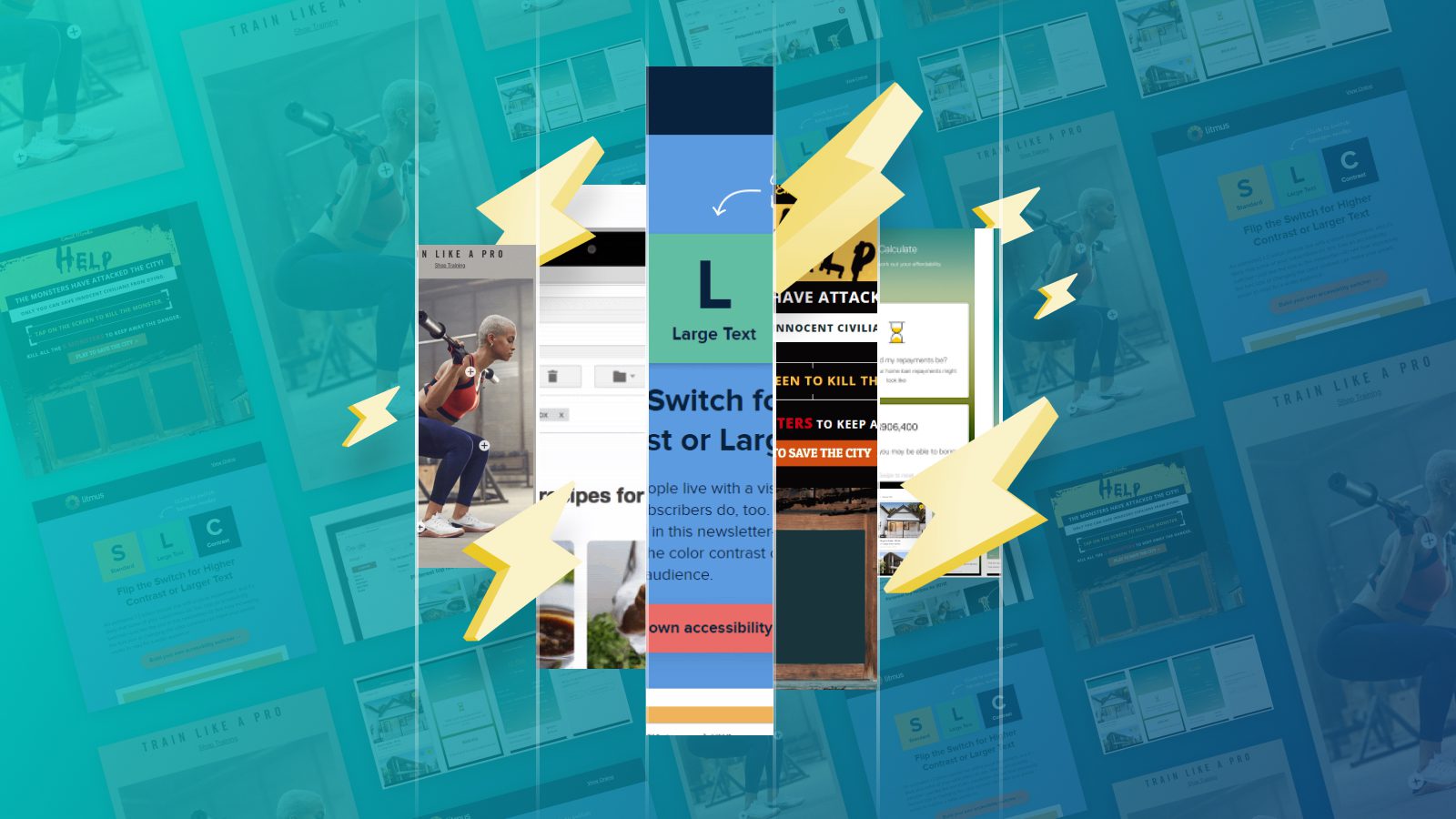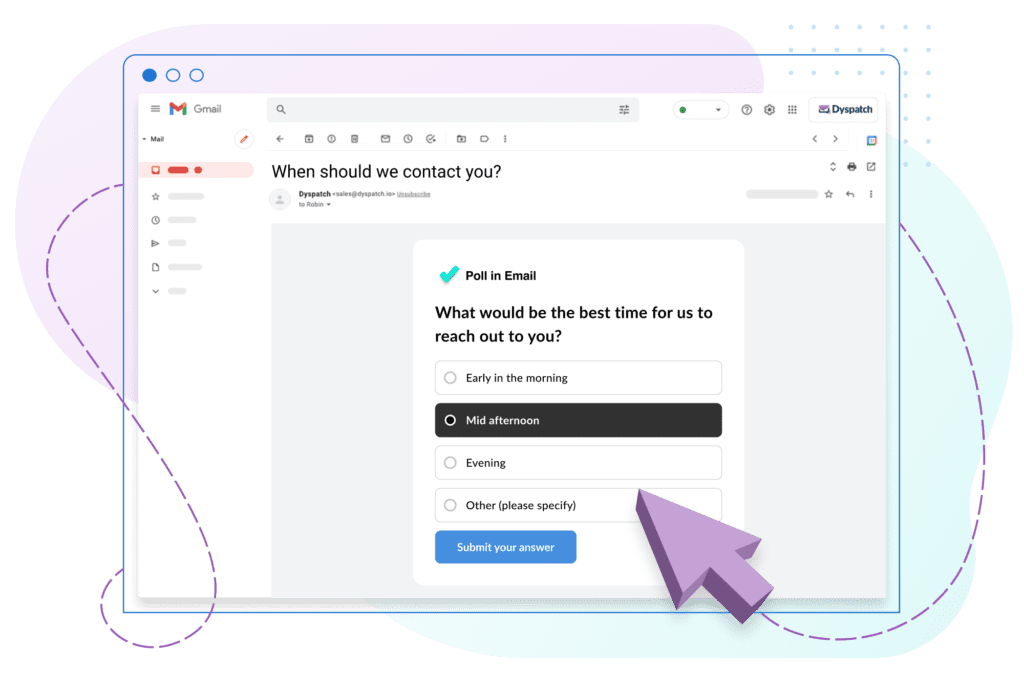AMP for Email enables a fundamental transformation in the way brands engage with their customers. Instead of being confined to static, one-way communications, companies can now provide a dynamic, interactive experience directly within the customer’s inbox.
While many of the early adopters have been leading-edge tech companies, AMP presents compelling possibilities for any business with a digital presence. In this article, we explore some of the most common use cases for AMP emails across four major verticals.
AMP for Email & Ecommerce
When it comes to ecommerce, AMP is a veritable swiss army knife. That’s why we’ve written multiple articles on how ecommerce brands can use AMP emails to reduce cart abandonment, improve the customer experience, and grow sales.
With so many options, it can be tough to figure out where to start. And not all use cases will necessarily be applicable to every brand. For instance, companies selling simple consumer products like T-shirts may not benefit as much from an AMP cart abandonment email with live chat support. And brands selling digital products like ebooks or event tickets won’t need an AMP delivery status email with real-time updates.
To keep things simple, we believe that ecommerce brands new to AMP should begin with the two most universal, customer-facing use cases in ecommerce: inbox shopping and gamified offers.
Inbox Shopping
One of the most common reasons for cart abandonment is an overly complex checkout process. The more steps you can eliminate in that process, the higher the chance that the customer will complete their purchase.
AMP allows you to streamline the shopping process by letting customers select the products they want directly within the inbox. Take this interactive email from Nike, for example:
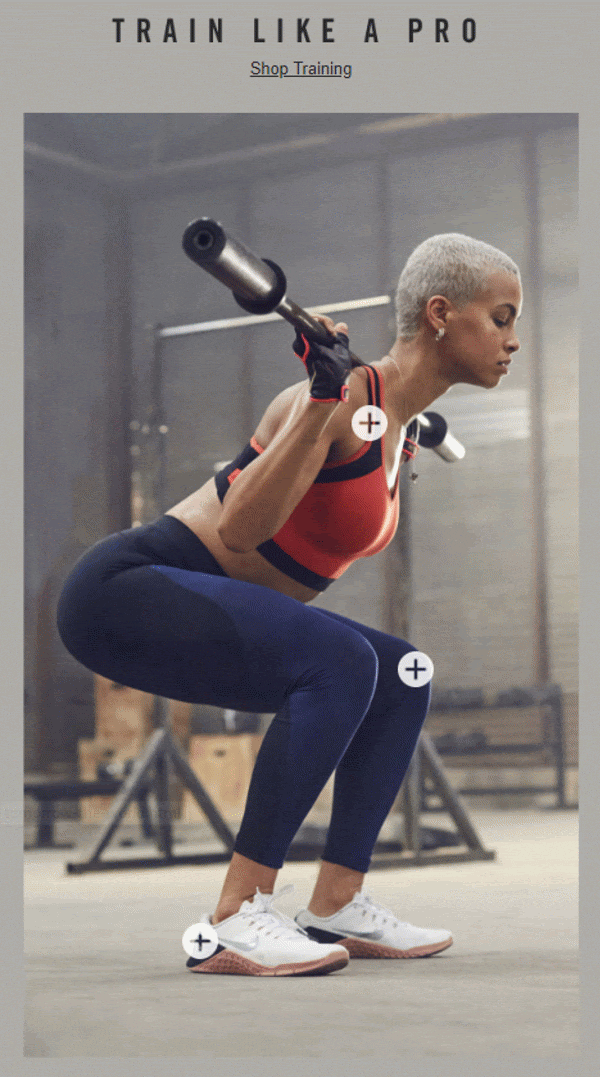
Aside from convenience, this email presents two powerful advantages over the standard shopping process:
- It presents a limited set of options, so customers are not overwhelmed by choice. This makes it psychologically easier for them to take action.
- It shows what the complete outfit looks like in an actual workout, instead of just presenting it as three separate pieces of clothing against a generic background. This makes the products more visually appealing, and allows the customer to picture what they would look like in “real life”.
This interactive email is already a significant improvement over its static counterparts, but AMP can make it even better.
For example, an option can be added to allow customers to switch the colors of each item in the picture. They should also be able to add each individual item to their cart, along with preferred color and size, but only if that item is still in stock.
In other words, every step apart from the final checkout and payment can be completed within the email itself, thus improving the user experience and reducing cart abandonment.
Gamified Offers
While customers always appreciate offers and discounts, they also tend to de-value your product if used too often. Gamified offers solve this problem by utilizing the IKEA effect, which causes people to place higher value on things which they’ve worked to acquire.
By requiring customers to “earn” the offer by playing a fun game, you can improve customer engagement while also making them more likely to actually use the offer or discount code they’ve won. And the offer doesn’t have to be limited to purchases either. You can also use it to incentivize social sharing, as in this creative example from Email Monks:
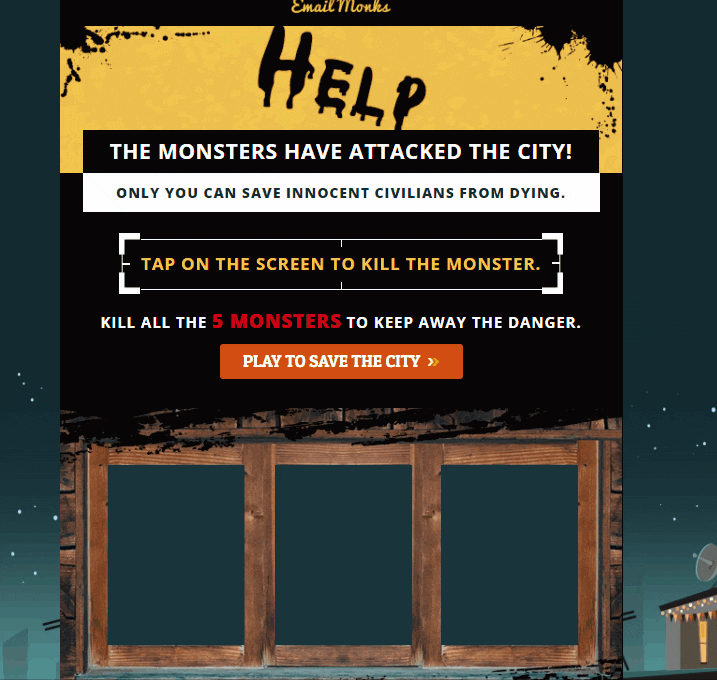
The sequencing of this email is perfect. First the customer has to play the game, which is a relatively small investment. Then, only once they’ve won do they get the “chance” to spread the word on Twitter, which is a relatively larger investment. It’s only after they’ve completed both steps that they get to win promotional merchandise – which they’re then more likely to actively use because they’ve “earned” it, thus increasing the brand’s visibility offline as well.
Well-designed gamified offers are a powerful way to set yourself apart as a brand, while also getting more mileage from your promotional offers.
Ecommerce Use Cases
| Promotional | Functional | Transactional |
|---|---|---|
| Reviews | Add/remove from cart | Product delivery status |
| List of up-to-date products | Purchase | Shipping status (connected to major shipping company APIs) |
| Product recommendations | Sign-up for “back in stock” updates | Abandoned cart reminders |
| Referral campaigns | Accordion to select different shopping categories | |
| Gamified discount codes | Click to load more products | |
| Latest social posts from Instagram / Facebook | Live chat |
AMP for Email & SaaS
For SaaS products, the possibilities presented by AMP go beyond promotional or transactional emails. Instead, the big opportunity is in product emails, that improve your software’s functionality or user experience in various ways.
Since these emails are likely to be seen regularly by current or prospective users, it’s important to think of them as part of your core product design. In other words, these emails should be owned by the product team, not marketing.
There are two common ways to leverage product emails: as an extension of functionality for current users, and as a demonstrative tool for prospective users.
Product Emails
Thanks to AMP’s dynamic, real-time interactivity, you can turn your customer’s inbox into an extension of your software. Rather than having to log on to your website every time they want to use your solution, users can access key functionality directly within an email, making for a much more convenient user experience.
Here’s an excellent example from Pinterest:
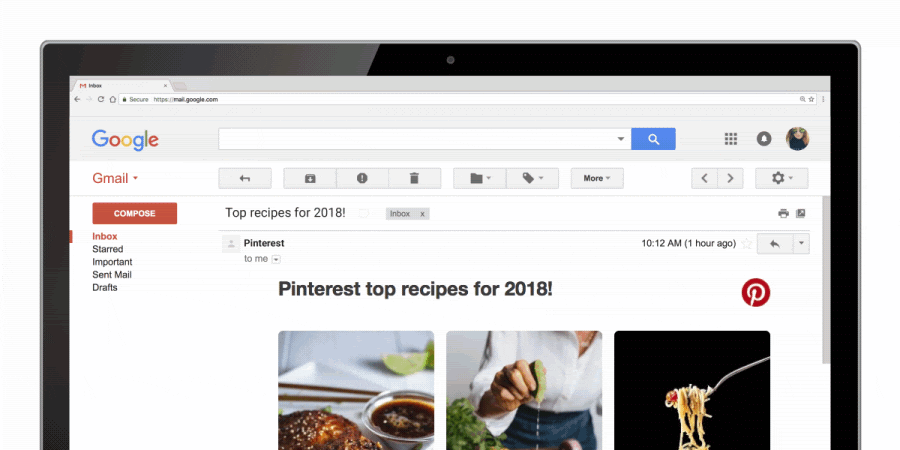
This AMP email combines a standard product update with seamless access to Pinterest’s core features. While a static email might be able to trigger engagement by presenting the right recipes to the user, it would still require them to click through to the web app itself.
AMP takes away that barrier by letting the user pin images directly within the email. And since the AMP framework is powerful enough to mimic Pinterest’s native user experience, it feels like you’re actually using the app itself, without having to leave your inbox.
It’s important to note that this email doesn’t give full access to all of Pinterest’s functionality. Not only would that be a lot of work, it’s also likely to overload the user. The key to great UX in the inbox is to provide a limited but timely and relevant experience, which will whet the user’s appetite and make them more likely to use the actual app itself.
Demo Emails
Often, the trick to getting new customers is to give them a chance to see what your solution can do. Demos and webinars have long been the best way to do this, but it can often be challenging to get people to sign up for them.
AMP emails offer a promising way around this, by giving prospective customers a first taste of your software’s functionality inside an email. Take this email from Litmus:
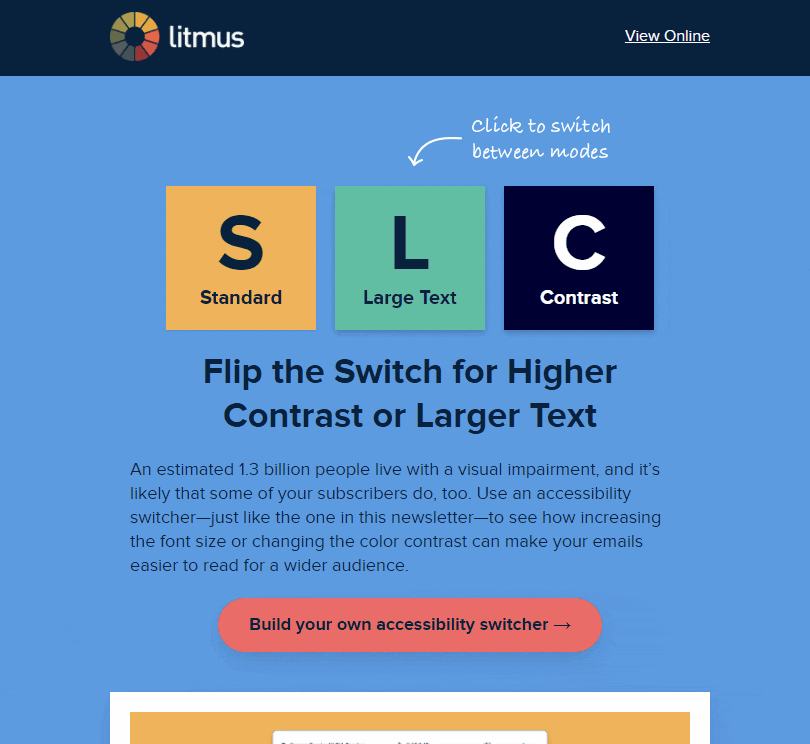
This email follows the classic storytelling principle to “show, not tell”. Instead of trying to explain why accessibility matters, and how their solution makes it easy to test your email’s accessibility, Litmus simply shows what their accessibility switcher can do.
Not only is this mini-demo much more compelling than even the best-written email copy would be, it also did not require the user’s explicit opt-in permission like a free trial would. Thanks to these strengths, demo emails have the potential to significantly raise conversion rates for any SaaS company with a good product.
SaaS Use Cases
| Product | Marketing | Sales |
|---|---|---|
| Onboarding flows | Mini-demos | Request a demo form |
| Live commenting | Live chat | Complete form for download (PDF, content) |
| Event RSVPs | Click to load more content (e.g. blog posts, white papers, videos) | Book a meeting through live calendar |
| Create a support ticket |
AMP for Email, Fintech, & Financial Services
For many consumers, personal finance is a complex topic, and choosing the right financial products and service providers can be a very challenging exercise.
As a result, banks, insurance companies, and fintech startups have a great opportunity to improve the customer experience by simplifying the buyer journey, and providing “just-in-time” consumer education along the way.
Apart from being more user-friendly, this customer-centric approach can help financial organizations to grow market share across every stage of the buyer journey. Since any consumer finance “project” requires multiple products and services, considering the customer’s holistic needs across the entire process can unlock more growth opportunities, instead of confining providers to one specific product type.
Take the home buying journey, for example. In order to buy a new house, the customer has to:
- Engage a realtor to help them find the right house to buy (and to sell their current house)
- Hire an appraiser to determine the fair market value of the house
- Contact a mortgage broker to get a loan
- Consult with their accountant to handle the transaction in a tax-efficient way
Since this isn’t their area of expertise, for most home buyers, the entire process involves many unknowns and a lot of stress.
As a result, some forward-thinking banks have stepped up with solutions to help home buyers navigate the process more easily. For example, Commonwealth Bank of Australia (CBA) launched a home buying app which lets users search for houses and see open house times, estimated market prices and the sales history of other houses in the same area. Users can also calculate their mortgage and apply for a loan with CBA directly in the app. The app was so popular it delivered an ROI of over 100% within six months of launch.
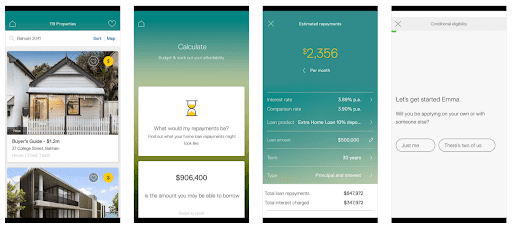
There are a number of ways AMP could further improve the functionality of this app.
Since the home buying journey can take many months, it can be tough to stay organized throughout the process. CBA could send emails to the user at each new stage, reminding them of next steps and allowing them to access the relevant functionality directly within the email.
For example, before the buyer commits to a purchase, they could be sent an AMP email with a mortgage calculator, to ensure that they can afford the monthly payments. The email could also include a CTA that allows them to send the results of their calculations to a CBA mortgage advisor with a single click.
If the buyer needs help with the app, they can be sent an AMP email with live chat functionality, thus allowing them to chat directly with a support rep without having to click through to a separate page. While it may sound like a minor change, when they’re already confused, the last thing a buyer needs is to jump through more technical hoops. It’s worth making the process as painless as possible, and that’s what AMP does best.
Fintech Use Cases
| Functional | Educational | Transactional |
|---|---|---|
| Mortgage calculator | Live chat | Mortgage or loan application status |
| Live stock prices | “Just-in-time” tips & educational content | Credit card activation form with live submit |
| Show updated active property listings | ||
| Book viewings |
AMP for Email & Consumer Services
Consumer services are a broad category, and include everything from travel to fitness to food and hobbies. In these verticals, the possible applications for AMP are a lot more diverse, and are really only limited by your creativity.
One especially universal use case, however, is the engagement email.
Regardless of the type of services you offer, every consumer brand needs a loyal core of devoted customers. And the best way to cultivate that passion in your customers is to nurture the relationship through multiple channels, including email.
Here’s a clever example from Xfinity:
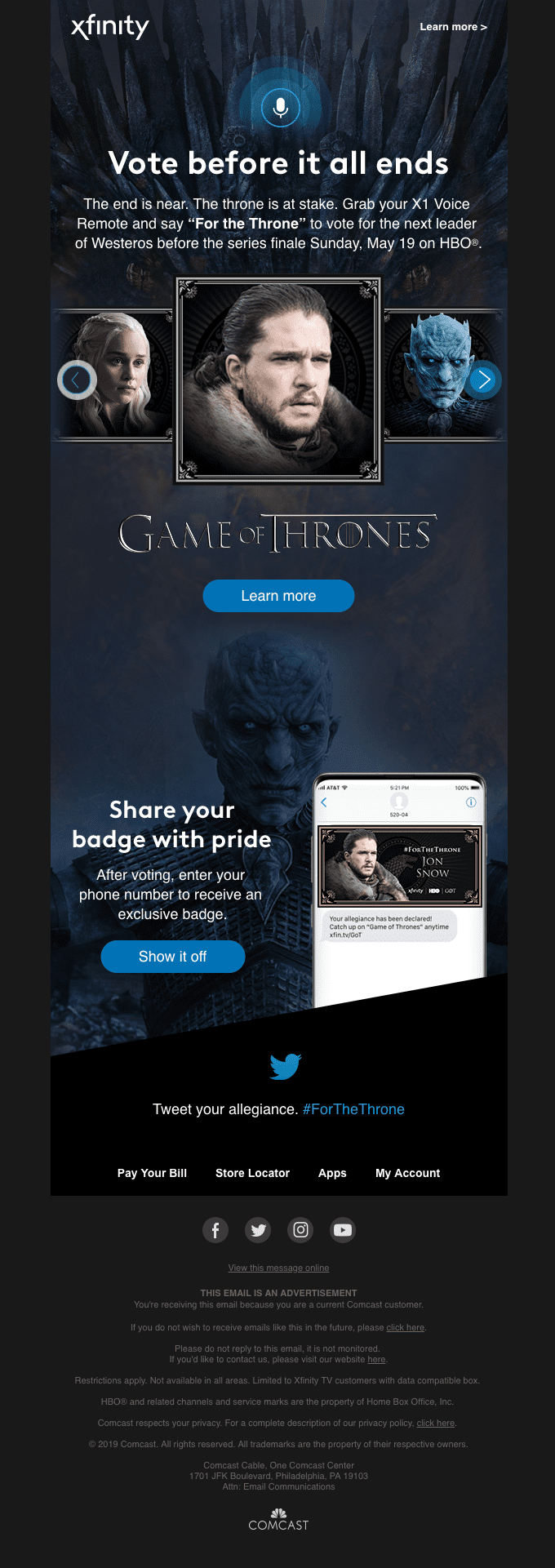
This email is not AMP-enabled, but it already presents a compelling form of engagement for Game of Thrones fans. Since a major part of the show’s appeal revolves around the fight for the Iron Throne, committed viewers will have fun picking sides and sharing their vote with friends on social media.
AMP can make this email even better by including a live update of voting results, which would further emphasize the social element and timeliness of the vote. And the email could even be sent out at the beginning of the final season, with characters being removed from the vote as new episodes air and key characters die.
While not every consumer service is as viscerally thrilling as a blockbuster HBO show, they can all benefit from the interactive, live engagement facilitated by AMP.
Consumer Services Examples
| Travel | Fitness Classes | Restaurants |
|---|---|---|
| Flight itinerary with live updates | Book classes through live calendar | Book/edit/cancel a reservations through live calendar |
| Instant upgrades from the inbox | Review instructors in the email | Send dietary restrictions to the restaurant ahead of time (allergies/sensitivities) |
| Live promotions on upgrades | Cancel registrations | |
| Select meal & seat preference | Sign up for membership | |
| Check-in | ||
| Flight delay announcements & live updates |
AMP for Email is for Every Brand
No matter what industry or vertical you’re in, chances are, AMP can help you build your brand, win more customers, and improve the user experience.
The best part is how easy it is to design AMP emails with no code required. To learn more, contact us for a demo of our no-code AMP email builder. If you’d like to learn more about AMP for Email, check out our in-depth AMP for Email white paper, which includes everything on how to get started from start to finish.
